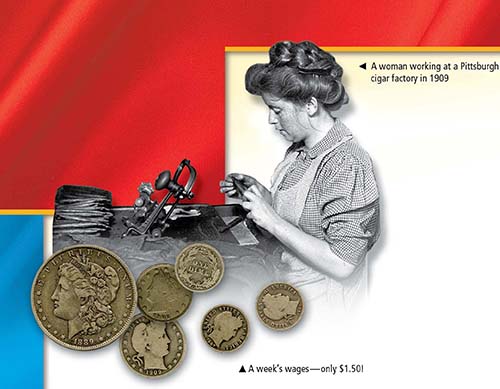SECTION 2: Women Make Progress
WITNESS HISTORY  AUDIO
AUDIO
Women at Work
As the Progressive Movement wore on, many reformers took up causes that affected women. Although women spearheaded a number of Progressive reforms, they did not have the right to vote in national elections. In workplaces like the Triangle Shirtwaist Factory, women endured the awful conditions described by one worker:
“It was a world of greed; the human being didn’t mean anything. The hours were from 7:30 in the morning to 6:30 at night when it wasn’t busy. When the season was on we worked until 9:00. No overtime pay, not even supper money…. When you were told Saturday afternoon, through a sign on the elevator, ‘If you don’t come in on Sunday, you needn’t come in on Monday,’ what choice did you have? You had no choice.”
—Pauline Newman, organizer of the International Ladies Garment Workers Union
Objectives
- Analyze the impact of changes in women’s education on women’s roles in society.
- Explain what women did to win workers’ rights and to improve family life.
- Evaluate the tactics women used to win passage of the Nineteenth Amendment.
Terms and People
- Florence Kelley
- NCL
- temperance movement
- Margaret Sanger
- Ida B. Wells
- suffrage
- Carrie Chapman Catt
- NAWSA
- Alice Paul
- Nineteenth Amendment
NoteTaking
Reading Skill: Identify Main Ideas As you read this section, complete an outline like the one below to capture the main ideas.
- Women Expand Reforms
- Hardships for women
Why It Matters In the early 1900s, a growing number of women were no longer content to have a limited role in society. Women activists helped bring about Progressive reforms and won the right to vote. In the years ahead, women would continue the struggle to expand their roles and rights. Section Focus Question: How did women of the Progressive Era make progress and win the right to vote?
Progressive Women Expand Reforms
In the early 1900s, a growing number of women wanted to do more than fulfill their roles as wives and mothers. They were ready to move beyond raising children, cooking meals, keeping the home tidy, and caring for family members. They wanted to expand their role in the community.
Education helped women achieve their goals. By the 1890s, a growing number of women’s colleges prepared them for careers as teachers or nurses. Some, such as Bryn Mawr College in Pennsylvania and the School of Social Work in New York, trained them to lead the new organizations working for social reform. Armed with education and modern ideas, many middle-class white women began to tackle problems they saw in society.
Working Women Face Hardships
For most women, however, working outside the home meant difficult jobs, with long hours and dangerous conditions. And these women were usually expected to





